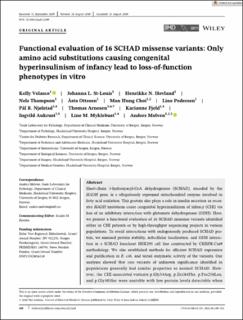| dc.contributor.author | Velasco Pinto, Kelly | |
| dc.contributor.author | St-Louis, Johanna | |
| dc.contributor.author | Hovland, Henrikke N. | |
| dc.contributor.author | Thompson, Nels | |
| dc.contributor.author | Ottesen, Åsta | |
| dc.contributor.author | Choi, Man Hung | |
| dc.contributor.author | Pedersen, Line | |
| dc.contributor.author | Njølstad, Pål Rasmus | |
| dc.contributor.author | Arnesen, Thomas | |
| dc.contributor.author | Fjeld, Karianne | |
| dc.contributor.author | Aukrust, Ingvild | |
| dc.contributor.author | Myklebust, Line Merethe | |
| dc.contributor.author | Molven, Anders | |
| dc.date.accessioned | 2021-04-16T08:54:22Z | |
| dc.date.available | 2021-04-16T08:54:22Z | |
| dc.date.created | 2020-10-11T19:23:04Z | |
| dc.date.issued | 2021 | |
| dc.Published | Journal of Inherited Metabolic Disease. 2020, 1-13. | |
| dc.identifier.issn | 0141-8955 | |
| dc.identifier.uri | https://hdl.handle.net/11250/2738040 | |
| dc.description.abstract | Short‐chain 3‐hydroxyacyl‐CoA dehydrogenase (SCHAD), encoded by the HADH gene, is a ubiquitously expressed mitochondrial enzyme involved in fatty acid oxidation. This protein also plays a role in insulin secretion as recessive HADH mutations cause congenital hyperinsulinism of infancy (CHI) via loss of an inhibitory interaction with glutamate dehydrogenase (GDH). Here, we present a functional evaluation of 16 SCHAD missense variants identified either in CHI patients or by high‐throughput sequencing projects in various populations. To avoid interactions with endogenously produced SCHAD protein, we assessed protein stability, subcellular localization, and GDH interaction in a SCHAD knockout HEK293 cell line constructed by CRISPR‐Cas9 methodology. We also established methods for efficient SCHAD expression and purification in E. coli, and tested enzymatic activity of the variants. Our analyses showed that rare variants of unknown significance identified in populations generally had similar properties as normal SCHAD. However, the CHI‐associated variants p.Gly34Arg, p.Ile184Phe, p.Pro258Leu, and p.Gly303Ser were unstable with low protein levels detectable when expressed in HEK293 cells. Moreover, CHI variants p.Lys136Glu, p.His170Arg, and p.Met188Val presented normal protein levels but displayed clearly impaired enzymatic activity in vitro, and their interaction with GDH appeared reduced. Our results suggest that pathogenic missense variants of SCHAD either make the protein target of a post‐translational quality control system or can impair the function of SCHAD without influencing its steady‐state protein level. We did not find any evidence that rare SCHAD missense variants observed only in the general population and not in CHI patients are functionally affected. | en_US |
| dc.language.iso | eng | en_US |
| dc.publisher | Wiley | en_US |
| dc.rights | Navngivelse 4.0 Internasjonal | * |
| dc.rights.uri | http://creativecommons.org/licenses/by/4.0/deed.no | * |
| dc.title | Functional evaluation of 16 SCHAD missense variants: Only amino acid substitutions causing congenital hyperinsulinism of infancy lead to loss-of-function phenotypes in vitro | en_US |
| dc.type | Journal article | en_US |
| dc.type | Peer reviewed | en_US |
| dc.description.version | publishedVersion | en_US |
| dc.rights.holder | Copyright 2020 the authors. | en_US |
| cristin.ispublished | true | |
| cristin.fulltext | original | |
| cristin.qualitycode | 1 | |
| dc.identifier.doi | 10.1002/jimd.12309 | |
| dc.identifier.cristin | 1838732 | |
| dc.source.journal | Journal of Inherited Metabolic Disease | en_US |
| dc.source.pagenumber | 240-252 | en_US |
| dc.identifier.citation | Journal of Inherited Metabolic Disease. 2021, 44 (1), 240-252. | en_US |
| dc.source.volume | 44 | en_US |
| dc.source.issue | 1 | en_US |

